Osteochondrosis is the cause of acute back pain in 67% of all cases. Lack of timely consultation with a doctor, consultation and treatment can lead to consequences such as dysfunction of internal organs, damage to the spinal cord and damage to the nerve roots of the spine. What is osteochondrosis, what types of treatment are available for patients and how the disease is diagnosed - read on.
What is osteochondrosis?
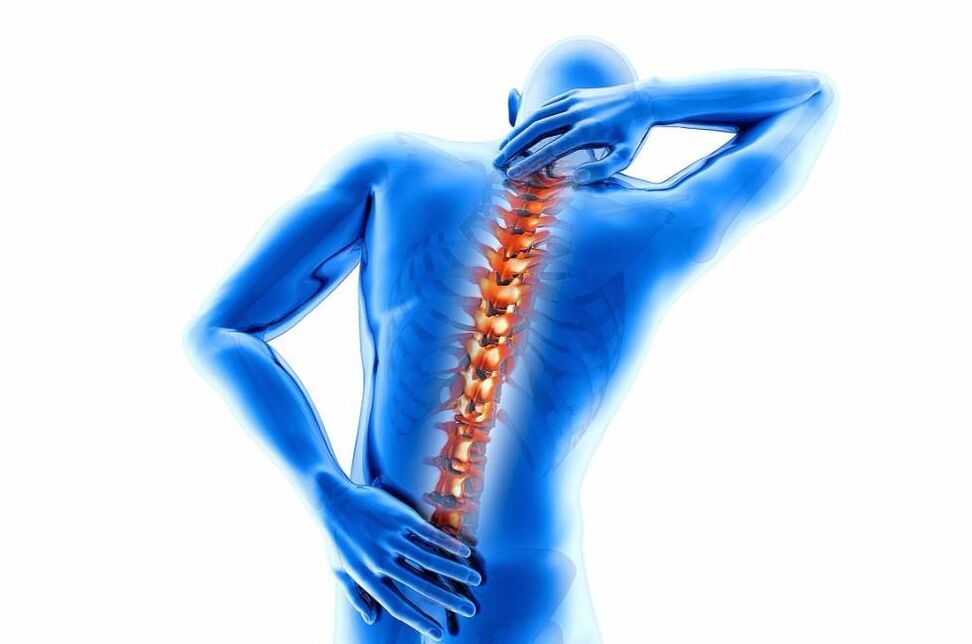
Osteochondrosis is a degenerative-dystrophic disease that leads to thinning of the intervertebral cartilage. Hyaline cartilage and intervertebral discs begin to "wear out", lose the ability to fully function.
Reference.In most cases, osteochondrosis of the spine is diagnosed in people older than 25 years. According to the WHO, as of 2021, 43% of the population aged 25-40 will suffer from osteochondrosis, and more than 92% of people in the elderly. The appearance and worsening of the disease can be caused by surrounding unfavorable factors.
Types of osteochondrosis
Every part of the spine is subject to degeneration processes. Among the types of osteochondrosis of the spine, 3 main ones can be distinguished: cervical, thoracic and lumbar (due to the heavy load, it is more common than others).
- Lumbar osteochondrosis.The lumbar region consists of 5 vertebrae that are subject to deformation due to the negative influence of external and internal factors. When nutrition and metabolic processes in intervertebral discs are disturbed, pain occurs, caused by loss of elasticity and thinning of cartilage tissue.
- Cervical osteochondrosis.The cervical spine consists of 7 vertebrae that are regularly exposed to stress. Pathological processes are activated when metabolic processes in the body fail.
- Thoracic osteochondrosis.The thoracic part consists of 12 vertebrae. This type of osteochondrosis is the rarest. The thoracic vertebrae are inactive. People who lead a passive lifestyle and regularly lift heavy objects are susceptible to disease.
Causes of osteochondrosis
The number of patients with osteochondrosis is growing rapidly every year. This is due to the fact that people spend most of their time on their feet, putting the maximum load on the intervertebral discs.
Important!With age/due to heavy loads, discs and cartilage deform. Fissures and hernias may occur. As a result, there is compression of nerve roots, thinned discs, pathological processes in the spinal cord, muscle spasms and progressive pain.
The risk group consists of: office workers, builders, hairdressers, sellers, drivers. Both men and women are equally susceptible to osteochondrosis.
Factors that cause osteochondrosis include:
- the presence of osteochondrosis in the family history;
- overweight, obesity;
- passive lifestyle;
- flat feet.
Depreciation disorder of the spine and its deformation can be caused by the following factors:
- Self-neglect (complete lack of physical activity or excessive exercise).
- Lack of awareness of proper postures to reduce stress on the spine.
- Constant work that involves lifting/moving heavy objects.
- Injuries.
Osteochondrosis: 4 stages of disease development
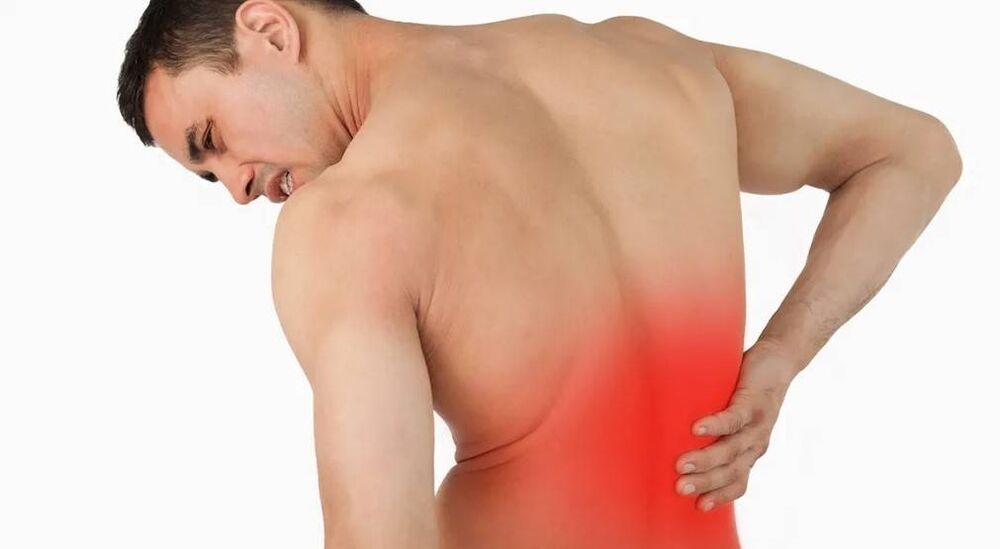
There are 4 stages of development of osteochondrosis of the spine:
- The first stage- there are no clear symptoms by which the disease can be diagnosed. Back pain occurs occasionally, often after physical exertion or overexertion. Osteochondrosis can be detected at an early stage by preventive examination or CT or X-ray examination.
- The second stage.The next stage is characterized by moderate pain. Cartilage tissue begins to deform, and the space between the spinal discs decreases. When contacting the doctor, drug therapy (to reduce pain) and physical therapy is prescribed.
- The third phase- the spinal column is deformed, fibrous surfaces and hernias appear, the pain intensifies and becomes more and more pronounced and frequent. At this stage, everything depends on the existing symptoms. The doctor will help determine the treatment method for the patient (conservative or surgical).
- The fourth stage- irreversible deformation of spinal function. It is almost impossible for the patient to move independently. The pain is acute, constant and increases with every physical activity. Pathological bone tissue fills the intervertebral space, the patient becomes disabled.
Symptoms of osteochondrosis
As mentioned earlier, there are 3 types of osteochondrosis and each of them is characterized by individual manifestations. Let's look at all the symptoms further.
Symptoms of lumbar osteochondrosis
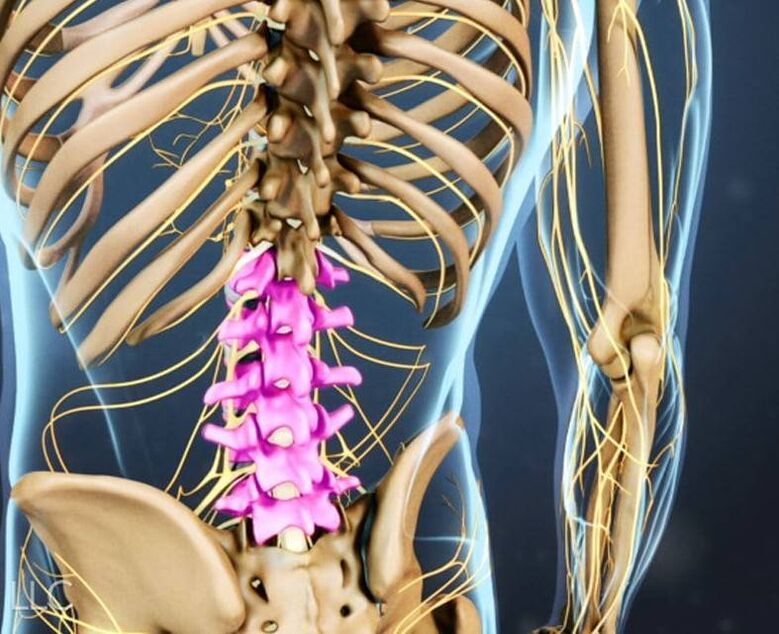
How to understand that you have lumbar osteochondrosis? You may notice characteristic symptoms:
- stiffness of movement;
- pain in the pelvis, sacrum, lower back and lower extremities, which becomes more intense with exercise or movement. The nature of the pain is painful, dull, sharp;
- pathological processes of the genitourinary system (problems with defecation and urination);
- weakness in legs;
- impairment/lack of sensitivity.
Important!Self-medication is strictly prohibited. When lumbar osteochondrosis is detected, diagnosis and effective treatment are mandatory. The consequences of the absence of therapy are hernias, protrusions, paralysis of the lower extremities.
Symptoms of cervical osteochondrosis

How to understand that you have cervical osteochondrosis? One or more symptoms may occur:
- frequent headaches;
- numbness of the upper and lower extremities;
- severe crunching in the cervical spine during physical activity;
- "spots", spots in the eyes, blurring and darkening;
- burning sensation and discomfort in the heart area;
- occurrence of tinnitus, hearing loss;
- causeless dizziness;
- pain in the shoulders, neck, arms.
Important!Osteochondrosis of the cervical spine is considered one of the most dangerous for people, because it complicates the process of blood saturation of the brain. If left untreated, bumps appear, then hernias. Surgical intervention in cervical osteochondrosis has a high risk of paralysis of the body. If symptoms appear, contact only qualified professionals.
Symptoms of thoracic osteochondrosis
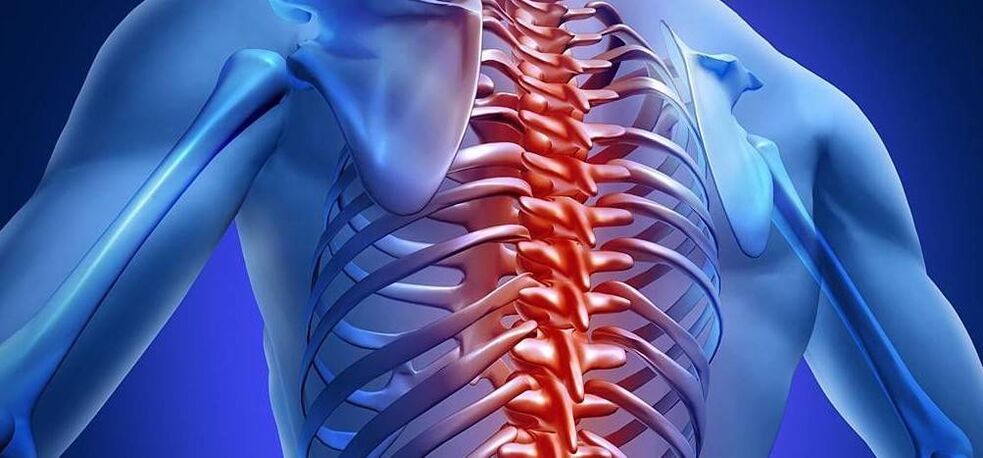
How to understand that you have thoracic osteochondrosis? Only a doctor (neurologist) can diagnose the disease, but the patient can assume the presence of osteochondrosis based on characteristic signs:
- discomfort, burning localized in the chest;
- the appearance of pain when raising the arms, pain in the shoulder blades;
- dizziness and sudden loss of consciousness occur;
- chest pain.
Reference.During the transition of the disease to the acute phase, dorsago (lack of air, sharp/stiff chest pain, "lumbago") and dorsalgia (pain can be episodic or constant, acute/dull) may occur.
Osteochondrosis of the thoracic spine is difficult to diagnose. The disease is often confused with angina pectoris, heart attack or inflammatory processes in the lungs.
Diagnosis of osteochondrosis of the spine
During the visit to the doctor, the collection of history and physical examination of the musculoskeletal system begins.
the patient's device. The specialist will check the integrity of the reflexes and the level of sensitivity of the painful areas. Blood tests and other laboratory tests are then ordered. In order to clarify the diagnosis, the neurologist prescribes one or more types of diagnostic imaging:
- Ultrasound of the vertebral arteries.
- X-ray of the entire spine or individual areas (cervical, thoracic, lumbar).
- CT of the spine helps to detect the presence of degenerative processes, displacements, deformations of the spine and its structures.
- MRI of the spine - identifies soft tissue pathologies, helps scan the spinal cord and intervertebral discs.
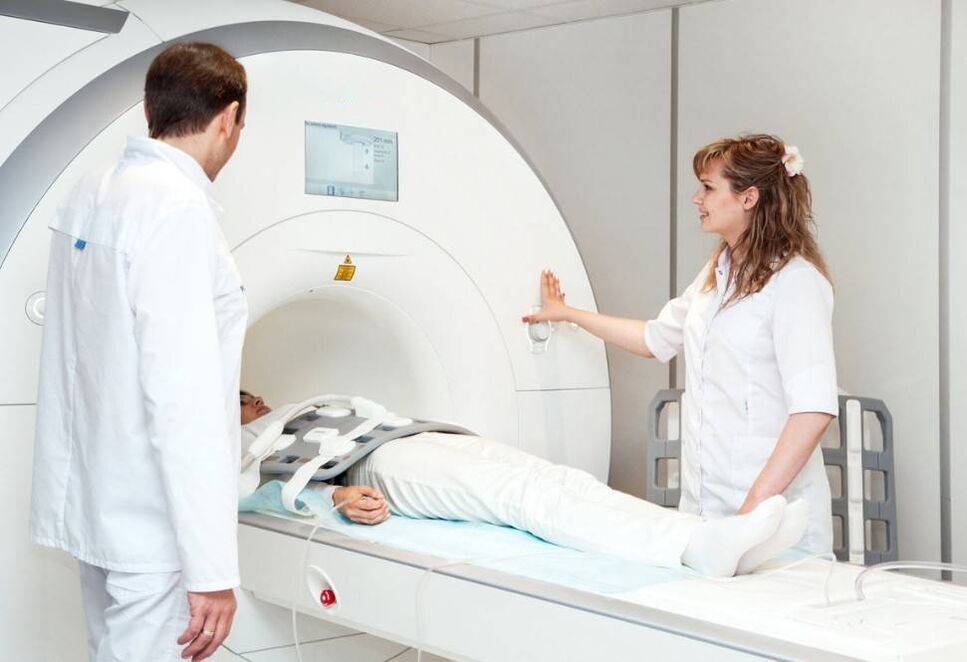
Treatment of osteochondrosis
How to treat osteochondrosis is determined by the doctor, depending on the type of disease, the severity of symptoms and the degree of pathological changes. The following can be used as therapeutic therapy: physiotherapy, drug therapy, chiropractor classes, therapeutic massage, exercise therapy or surgical intervention (in the absence of positive dynamics from other treatment methods or in an advanced stage).
Treatment of osteochondrosis with drugs
When prescribing medical therapy with drugs, the doctor can use several groups of drugs at once:
- NSAIDs (non-steroidal anti-inflammatory drugs) - to relieve the symptoms of osteochondrosis, relieve pain and reduce inflammation. It can be used in tablet form or as injections (in severe cases). The duration of the treatment is from 7 to 14 days;
- chondroprotectors – to strengthen intervertebral discs and cartilage tissue;
- B vitamins;
- vascular drugs - to improve blood supply to the spine;
- glucocorticosteroids - used as injections in the affected area (in severe forms of the disease);
- muscle relaxants - to relax muscles, relieve pain and inflammation.
Massage for osteochondrosis
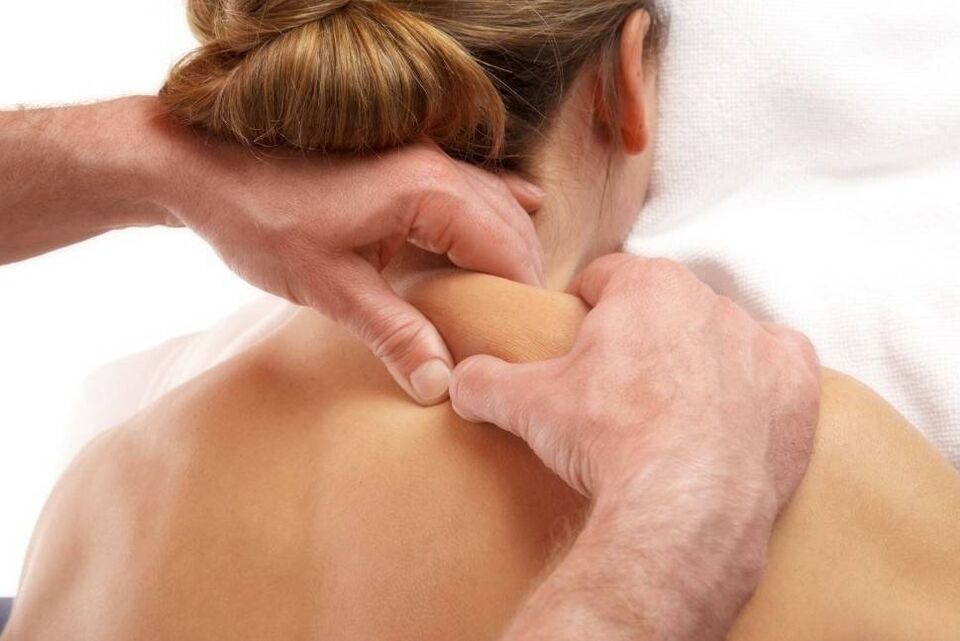
A course of massage for osteochondrosis must be done once every six months. Therapeutic massage removes tension, relieves tension and improves blood circulation in the affected area. Only a doctor can say about the advisability of prescribing a massage, a prerequisite is the remission of the disease.
Traction (spinal traction)
Artificial traction of the spine is carried out only under the supervision of medical personnel, using special equipment. High-quality traction enables an even distribution of vertebrae in the spine. Pain, pinching and inflammation are reduced.
Manual therapy
Manual therapy of osteochondrosis of the spine is used to correct the curvature. The specialist applies targeted action to the patient's muscular and skeletal system. After the therapy, blood and lymph circulation improves, stiffness disappears and mobility appears.
Physiotherapy treatment of osteochondrosis
It is used only in the period of remission of the disease, and in the acute phase this method of treatment is prohibited. Physiotherapy is used as an adjunctive therapy, along with drug treatment. To reduce symptoms of osteochondrosis, experts use laser, magnets and electricity (low frequency).
Acupuncture
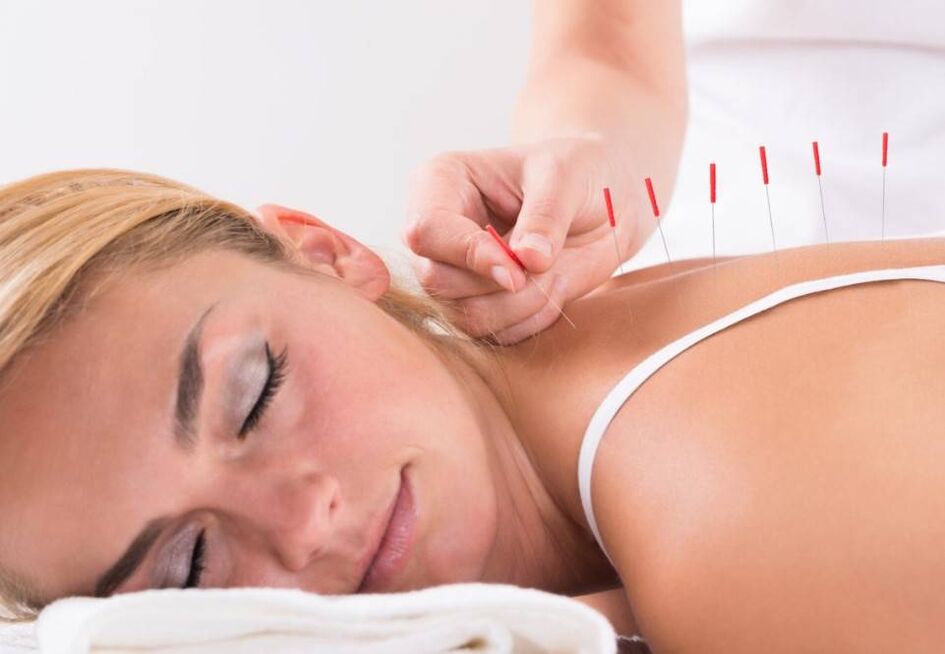
The basis of acupuncture is proper action on reflex zones and pain points. Therapy is prescribed only in combination with therapeutic massage to increase efficiency. The therapy restores the possibility of natural loading of the spinal column without pain.
Exercise therapy for osteochondrosis
Physical therapy is effective for all types of osteochondrosis and can be prescribed to patients of any age category. The type of exercises and the duration of their performance is prescribed by the doctor. Moderate physical activity helps to strengthen the back muscles, increase the mobility and flexibility of the spine, and improve the patient's condition.
The patient can be prescribed the following types of classes: kinesitherapy, therapeutic swimming, health care, mechanotherapy.
Important!Exercise therapy classes are contraindicated in periods of exacerbation of osteochondrosis!
Surgical treatment of osteochondrosis
For osteochondrosis of the spine, surgery is rarely prescribed as the only treatment option. The human spine has a complex structure with many vertebrae and nerve endings that affect the coordinated functioning of the entire body. With surgery, there is a high risk of complications, so it is prescribed only in the most severe cases or in the absence of improvement from other treatment methods.
Prevention of osteochondrosis of the spine
Prevention is the best way to reduce the risk of developing osteochondrosis and achieve remission of the existing spine disease. The main thing to remember when performing preventive exercises is that they should be regular and only during the period of remission.
It is better to simultaneously perform a gymnastic set of simple exercises. In order not to forget about them, set a reminder on your mobile phone or include them in your morning hygiene rituals.
- Rest your forehead on your palm, tense your neck muscles. Execution – 3 sets of 5-7 seconds each. Then repeat the same with the back of the head and palm.
- The position of the shoulders is straight, the head is straight. Slowly tilt your head as far as possible to the right and then to the left. Perform 5 times (slowly).
- Slowly tilt your head back a little. Tighten your neck muscles and gradually move your chin towards your chest. Do 5-7 times.
- Place the left palm near the left temporal area (then the right palm and the right temple). Press the palm, straining the neck muscles. Execution – 3 times for 10 seconds.
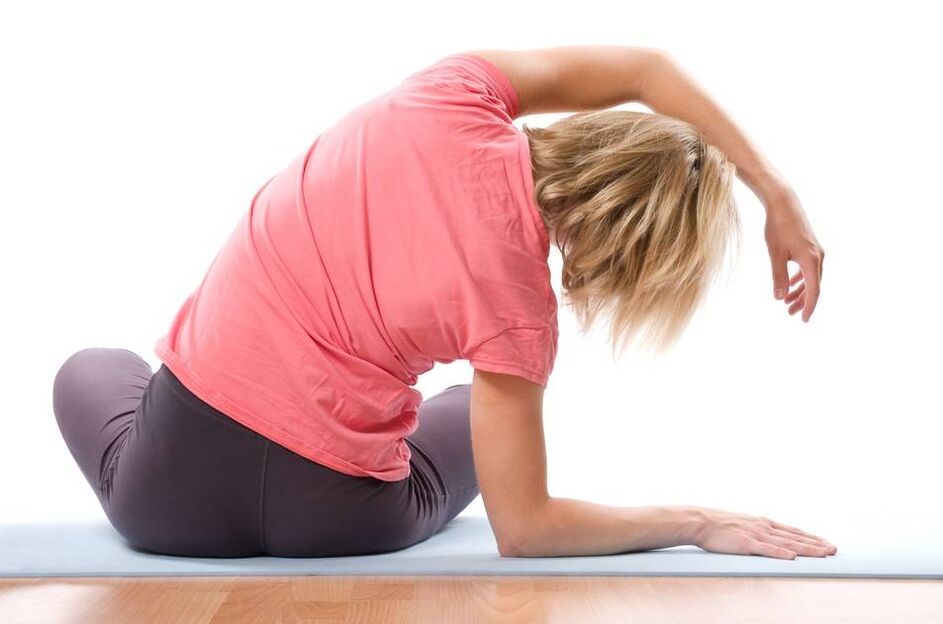
Important!Do not rush when doing the exercises. Circular head movements are also prohibited due to the high risk of injury and pinching of nerve endings.
The second set of preventive exercises against osteochondrosis can be performed at any time (especially after work or overexertion), but also regularly:
- Stand straight, legs together, arms relaxed, take a deep breath. Raise your arms up, exhale. Access – 6-8 times.
- Lie on your stomach, hands next to your body, relaxed. Bend up, rest your arms, try to raise your head and feet. Stay in this position for 5 seconds. Return to the starting position. Repetition – 5-7 times.
- Sit on the chair. Put your hands behind your head (inhale deeply), bend back 4-5 times so that your shoulder blades touch the back of the chair (exhale). Repetition – 5-7 times.
- Stand up, bend down, take a deep breath. Relax your hands, lean forward, slowly lower your head and shoulders - exhale. Access – 10 times.
- Get on all fours. Head straight. Arch your back and stay in this position for 3-4 seconds. Return to the starting position, repeat 5-7 times.
How to stand, lie and sit with osteochondrosis?
Knowing the correct positions that help to evenly distribute the load on the entire spinal column is necessary not only for patients suffering from osteochondrosis, but also for all people. By following simple rules, you will notice a significant improvement in your general condition and a reduction in the load on your back. In addition, you can protect your spine from many diseases with serious, painful symptoms.
How to sit properly?
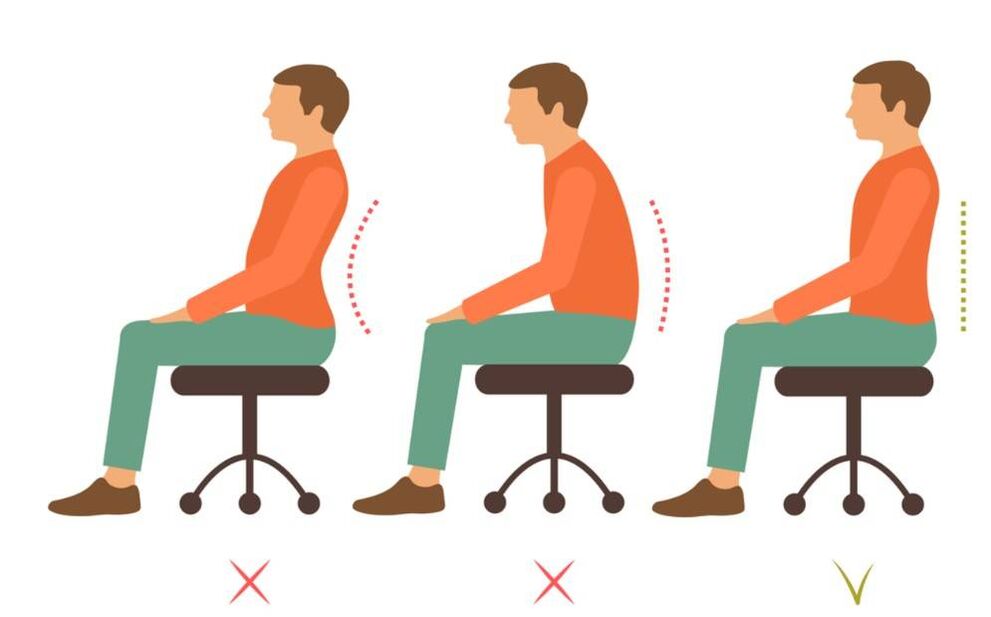
We learn to sit without squeezing, without causing the risk of spine deformation and the development of osteochondrosis:
- criteria for choosing a chair/stool: seat depth level - 2/3 hip length, seat height should be equal to lower leg length. That way, your feet will rest on the floor. Small people must place a small step or bench under their feet;
- pay attention to the depth of the work surface. It should be such that the legs do not have to be held at the sides or strongly bent;
- When working for a long time while sitting, take a break every 20 minutes. Change the position of your legs, walk around, do light gymnastics;
- sit behind the wheel with minimal stress. Your back should be against the seat; a small pillow or bolster placed between the chair and the lower back will help you with this. If possible, get out of the car every 25-30 minutes to warm up;
- Heavily upholstered furniture is not good furniture for everyday use. To evenly load the spine, it is necessary to rest the body on the ischial tuberosities, which is possible only while sitting on a medium hard surface;
- Your back should always touch the back of the chair/desk. Try to sit upright, avoiding strong bending of the neck;
- do not sit/lie down in one position for a long time.
How to stand properly?
If a person stands for a long time in one position, there is a strong load on the lumbar part (and the entire spine), which has a negative effect on him. To avoid overloading the spine and increasing the risk of deformation, follow simple rules:
- do not stand in one position for more than 10 minutes, change the position of your legs and arms;
- relieve tension in the neck - tilt your head to the right and left, stretch your arms forward, bend your back forward and back - relax your back and lower back;
- when lifting something from the floor, bend down, bend your knees or squat, find support for your hands;
- move, walk short distances so as not to stand still;
- try not to bend too much (back, head) during housework (cleaning, ironing, cooking). When cleaning low or hard-to-reach surfaces, get down on one knee.
How to lie down?
The ideal choice of sleeping mat is a bed with a medium-hard mattress (ideally an orthopedic one that preserves the physiological curves of the spine). The bed must not be wooden or too soft.
How to lie down properly if you have severe pain?
- back pain - lie on your stomach, put a small pillow under the lower back (so as not to increase the pain by bending over);
- pain in the legs - put a pillow (from a towel or blanket) under the knee. The pain syndrome will gradually decrease;
- neck pain - put your hand under your head or a pillow under your neck.
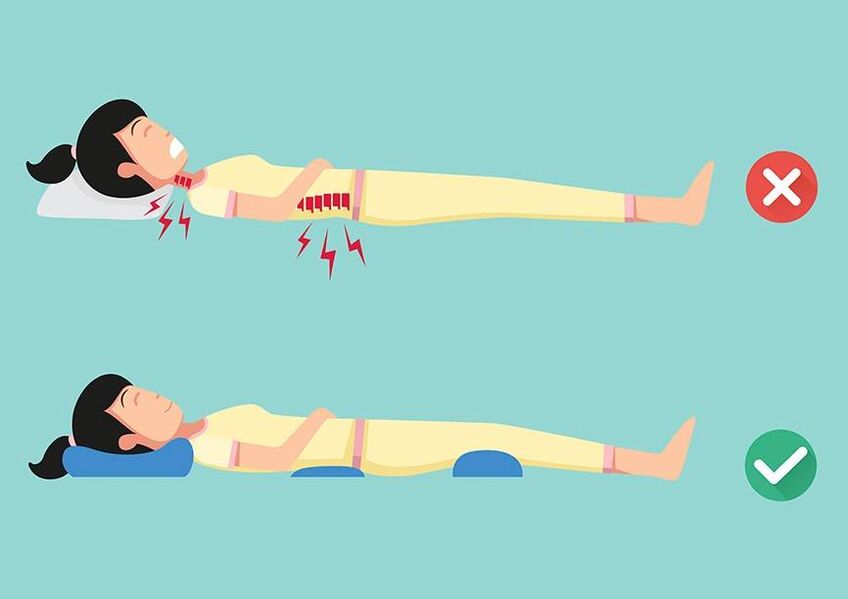
How to get out of bed in the morning during an attack of osteochondrosis?
- do a short warm-up of the upper and lower extremities;
- change your position;
- move from a lying to a sitting position, grasping the leg with the hands bent at the knee;
- lower your feet to the floor one at a time;
- stand up gradually, any sudden movement can increase the pain.
How to properly lift and move weights?
Improper lifting and carrying of heavy objects is one of the most common causes of hernias, osteochondrosis and protrusions. Sharp weight lifting is fraught with sudden "shooting" in different parts of the spine and the appearance of acute pain that will last for a long time. Turning the body when carrying heavy objects is also prohibited.
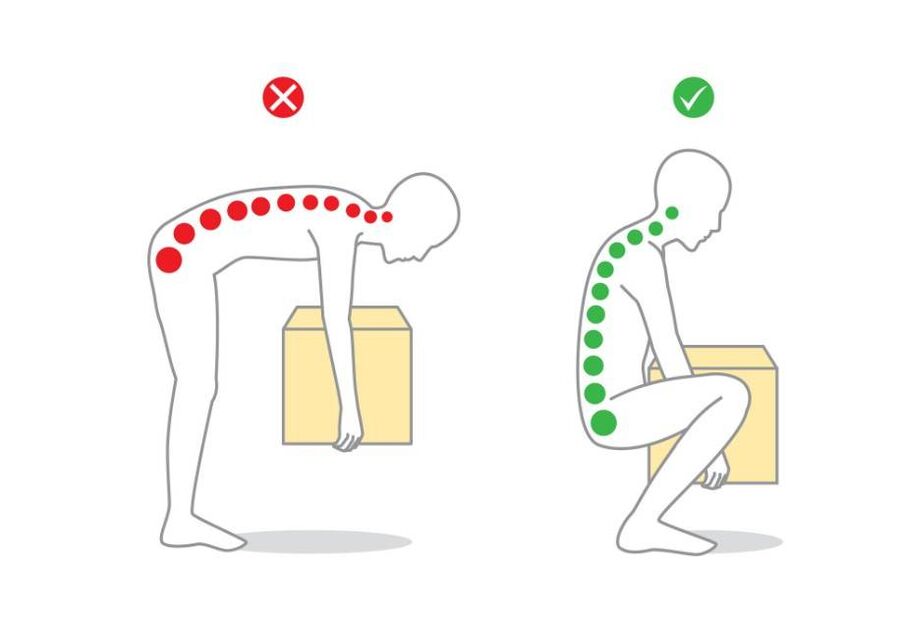
How to lift a heavy object?
- Wear a wide belt.
- Squat down. Keep your neck and back straight.
- Secure the object with both hands, rise slowly, keep your back straight.
How to move a heavy object?
- distribute the load evenly on both hands, do not carry everything in one;
- with diagnosed osteochondrosis, it is not recommended to lift more than 15 kg;
- buy a backpack (an important condition is an orthopedic back and wide shoulder straps). The advantages of using a backpack are an even load on the spine + free hands;
- Do not lean forward or backward suddenly.
Conclusion
Osteochondrosis of the spine most often develops at the age of 25-40. The risk group for morbidity includes people with a passive lifestyle, those who spend most of the time standing or in irregular positions, with a heavy load on the spine. Osteochondrosis can be cured by conservative methods, with a timely consultation with a specialist. In advanced cases, surgical intervention is used. Self-medication is contraindicated.
Regular preventive exercises will help reduce the symptoms of osteochondrosis and maintain the functionality of the spine, protecting against deformations. If you neglect your health, the patient may delay going to the doctor until hernias, paralysis and disability appear.






















